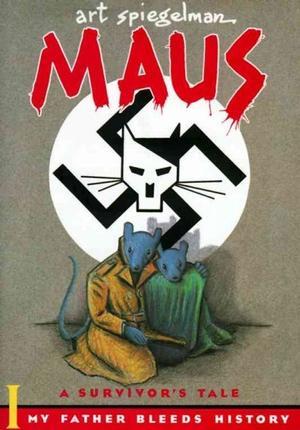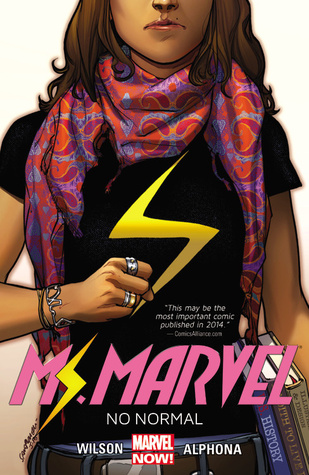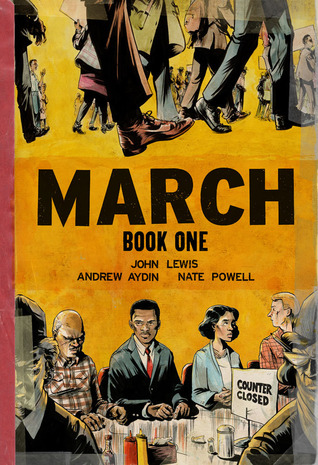I summarize the following ten novels (not in order):
- American Born Chinese by Gene Luen Yang
- A Contract with God by Will Eisner
- Maus by Art Spiegelman
- Persepolis by Marjane Satrapi
- March: Book One by John Lewis
- Safe Area Gorazde by Joe Sacco
- The Arrival by Shaun Tan
- The Property by Rutu Modan
- Ms. Marvel: No Normal by G. Willow Wilson
- All-Star Superman Complete by Grant Morrison
 |
| From Goodreads |
Tan, S. (2006). The arrival. New York: Arthur A. Levine Books.
Shaun Tan’s The Arrival is a brilliant wordless graphic novel sharing the tale of an immigrant in his new city after leaving his wife and daughter. Each panel shares the struggles of going to a new and strange world. The wordless nature brings attention to the fact that everyone speaks a different language, and yet they still can communicate. The communication takes place with drawings and gestures. Each new person which the immigrant meets has a unique story to tell of why they are in their new land. The story has strange animals and sights giving the world an unfamiliar feeling drawing readers into the story. Tan uses double-page spreads to tell his story, even having panels crossover both pages instead of the traditional single page spreads to tell his story. This book is a marvelous example of what a graphic novel can do using simple images. Tan’s book should be part of graphic novel canon and I would recommend the book to anyone interested in seeing the life of immigrants. This book is unique in that it is wordless but the fact that it is wordless adds to the beauty of the book and the story. Even without words readers are engaged and can understand what the characters are feeling. Tan’s book is a must read for anyone who enjoys graphic novels.
Maus
 |
| From Goodreads |
In Maus Spiegelman tells his father’s sad and moving story of surviving the Holocaust as a Polish Jew. Spiegelman uses animals to depict the characters in his narrative: Jews are mice (maus in German), Poles are pigs, and Germans are cats. This is fitting because just as cats hunt mice, the Germans were hunting the Jews. Maus is divided into six chapters, each telling one part of Vladeck (father) and Anja’s story. Each of these chapters has a skillfully drawn cover image with the title displayed. Maus shares not only Vladek’s story of how he and Anja survived WWII by hiding from the Gestapo but also the interactions of Vladeck and Arti (Spiegelman) while Spiegelman was recording the story for the book. The interjections share life as it is now, after the war, after Anja died, and after Art had grown and was living on his own. While the first narrative is heavy and dark, both in style and content, the second has elements of humor and levity. Spiegelman adds a third narrative into the story in Chapter 5 about his mother’s suicide and the effect it had on the family. These pages use dark backgrounds and more deliberate shading, also while the rest of the book uses animals to tell the story this inset uses people to share Anja’s story. Maus is a good read for those interested in learning about the effects of WWII from a Jewish perspective. Maus is a great addition to any graphic novel collection adding historic elements to the canon
Ms. Marvel: No Normal
 |
| From Goodreads |
Wilson, G. W., and Alphona, A. (2015). Ms. Marvel: No normal. New York: Marvel.
Ms. Marvel tells the story of Kamala, a Pakistani-American teen, trying to discover herself. Wilson’s writing is fast paced and exciting, pairing wonderfully with Alphona’s vibrant illustrations. Together they create a world where anything is possible if you believe; the way they create Kamala allows readers to understand and connect with her, making you believe everything that comes to pass. Kamala struggles with trying to be herself, which is difficult because she wishes to have her own way but must follow the strict religious and social boundaries established by her parents. Each section begins with a full-page image of Kamala as she masters her new-found powers. Different sized panels tell the story, some panels are small insets within larger images, while other take up whole pages. The panels are arranged in a traditional manner, with some overlapping one another or covering the entire page width. Yellow text bubbles allow readers to view character’s thoughts and provide an internal narrative for the characters helping readers understand why they do something. Ms. Marvel is a well-written origin story with skillfully drawn images. Kamala like other heroes has a friend who she tells about her powers, but will not tell her family. Ms. Marvel provides a modern look at who can be a superhero by giving the graphic novel canon a new fresh image for female superheroes.
American Born Chinese
 |
| From Goodreads |
Yang’s beautifully illustrated volume tells the stories of Jin Wang, Danny, and the Monkey King. Jin is a young Chinese-American boy trying to fit in with his new classmates but is always reminded of being the outsider. While Danny is a teenage boy who has just begun to fit in at his new school (the third in three years), until his cousin, Chin-Kee, shows up. While Jin feels that he does not fit in Danny is embarrassed by his cousin and feels that everyone makes fun of him not because of who he is but who his cousin is. The final story is that of the Monkey King. Monkey desires to become a god, mastering all twelve aspects of Kung Fu to become immortal. In all three stories, the characters must learn the same lesson, to be themselves. Yang’s colorful illustrations accompany each story, all three stories are told in a similar style. The story of Chin-Kee has a unique feature, at the bottom of some panels Yang has placed the words “HA HA HA” or “CLAP” in bubble letters, this indicates to the readers the embarrassment Danny feels around his cousin. The words add a sense of uneasiness to the frames. Yang also uses slanted gutters which cut diagonally across the panels adding a sense of movement to the scenes not accomplished by traditional gutters. American Born Chinese is a fascinating read for anyone who feels out of place. The graphic novel belongs in the cannon and helps readers learn to be themselves.
March
 |
| From Goodreads |
Lewis, J., Aydin, A., and Powel, N. (2013). March: Book one. Marietta, GA: Top Shelf Productions.
March: Book One is written by John Lewis and reflects on his work during the Civil Rights Movement. Lewis shares his experiences in a flashback tale with two boys and their mother on the day of President Obama’s inauguration. The first story Lewis shares is about how he grew up on a farm helping raise the chickens, in this story we see his compassion and humanity. The second story tells of how Lewis gained interest in helping African-Americans gain equality and justice. He tells of how his favorite uncle arranged for him to take a trip to the North for the summer, where he saw the difference in how African-Americans were treated there. The reader is shown how Lewis joined the movement and met Dr. Martin Luther King because of a desire to help desegregate a university near his home. While that did not happen John Lewis would become an integral part of the sit-in in Nashville as a member of The Nashville Student Movement. The black and white drawings bring a somber tone, showing the importance of what was taking place during the Civil Rights Movement. Each panel deliberately shows emotions of the characters in the story. The panels are unique with some having only two borders with others having no borders. These different shaped panels add to the story and show the passage of time or action. The novel belongs in the canon playing an important part in telling the history of the American Civil Rights Movement.
A Contract with God
Eisner, W. (2006). A contract with God: A novel. New York: W.W. Norton.
 |
| From Goodreads |
All-Star Superman
 |
| From Goodreads |
In All-Star Superman readers are introduced to the “human” side of Superman seeing his mortality. Morrison’s reimagined Superman is powerful and compassionate. The twelve-episode story tells how Superman is dying from solar poisoning. Lex Luthor is the cause of all the trouble for both Earth and Superman because he does not want to die for the crimes he committed. The story explores what a world without Superman would look like and how he might save himself. Each story adds to the life he led as Clark Kent and Superman. Quitely’s art is vibrant and action filled, enhancing the story told by Morrison. Each panel is skillfully drawn to engage the reader with the story. The first three stories each have small inset panels to begin the episode, while the remaining nine only have the full-page images. One unique panel set is in Episode 5 where the bottom middle panels open into the gutter creating a background. This overlap into the gutter creates a larger flow for the characters in the jail scene and readers feel as if they are part of the crowd. All-Star Superman is an exciting twelve-part adventure with Superman and those he meets. The story is well told and even those who do not know the origin story can relate to it, feeling attached to the characters. The art adds to this attachment allowing readers to use closure to fill in many gaps and enhance the story. This graphic novel provides the cannon with a delightful superhero adventure.
Persepolis
 |
| From Goodreads |
This graphic memoir shares Satrapi’s story of growing up during the time of unrest in her homeland. The dark ink illustrations show the mood of the time, fear. Each panel is filled with suspense and secrecy. Satrapi relies on closure from the readers to keep the story moving and to fill in the more gruesome details. The text tells the story in both word bubbles and text boxes along the top and bottom of panels. Though only 153 pages long this book spans many years and difficulties for Satrapi, her family, and her friends. Each chapter opens memories of darker times starting with the Revolt and ending with Marji leaving for Austria alone. The graphic novel shares the poverty, fear, massacres, and danger facing the people of Iran during the change in power from the King to the Shah and finally the Islamic Republic. The author shares how the media would twist stories to try and gain the people's trust all while the government was killing their own people who disagreed with them. Persepolis tells an important part of history and helps those who are not familiar with the fight in Iran/Middle East better understand what the people are struggling with every day. This graphic novel also is relatable to many people, because Marji is a typical rebellious teenager, making her a familiar and accessible character. The sad truth of the story is seen in most chapters making the content difficult to read at times but important to understand. Persepolis is a well written and illustrated memoir which belongs in the cannon of great graphic novels.
The Property
 |
| From Goodreads |
The Property tells the story of a grandmother and granddaughter who return to Warsaw in search of their property. The vibrant colors of the illustrations dramatize the story from the perspective of both characters drawing readers into their lives. In Warsaw, Regina seeks out an old flame, from before the war, because of a secret they share which Mica does not know. Mica meets a young man who gives tours of the Jewish section of town and begins to fall for him, even though he is not Jewish. Intermixed with these two stories is the story of Yagodnik, a family friend, who is trying to take the property for Regina’s daughter (Tzilla). The story has been translated into English but indicates which language is being spoken with the font used for the words. Hebrew is shown with all caps, while Polish is italicized, and English is in mixed (standard) type, a fourth type of speech bubble has only squiggles representing when a character is hearing an unknown language. This feature allows the readers to understand the situation from a specific character’s perspective and makes them more relatable. One unique panel sequence is during Day 3 when Mica is speaking with a lawyer and Yagodnik is speaking with Tzilla. This three-page set of panels uses a burgundy background for Mica and a basketball setting for Tzilla to show the two separate conversations. The Property is a stunning example of a historical graphic novel and provides a unique perspective on Jews returning to Poland long after World War II.
Safe Area Gorazde
 |
| From Goodreads |
Sacco, J. (2000). Safe area Gorazde: The war in eastern Bosnia 1992-95. Seattle, WA: Fantagraphics Books.
Sacco recounts his time visiting Gorazde during the Bosnian war as a journalist and the friends he makes while there. The war isolated and nearly destroyed the city of Gorazde during the heat of the war. The sad stories of the citizens are recounted in somber tones and dark black ink. The illustrations and text tell a story of the horrors seen by the survivors of the firefights with the Serbs. Sacco uses different colored gutters to show the story from his perspective (white) or that of the survivors (black). The black gutters appear to represent the dark times they have seen. Another unique feature of the graphic novel is the mix of text boxes and word bubbles to tell the story. Textboxes show the narration provided by Sacco, while bubbles show the dialogue of characters in each frame. This sad story is important for all to understand so that there is not a repeat of this horrible war. The graphic novel shows the impact that the war had on the citizens of the country and city, even after there was peace declared. The men and women represented are uncertain of their future and hope for a better life. The novel should be in the canon, even though I did not enjoy it because it tells an important story and represents a unique style and perspective.
Credits: All cover images are from Goodreads.com posts, each annotation begins with an APA citation crediting the author(s) and/or illustrator(s).
UPDATE: This blog post was edited and reposted to include credits line and correct Satrapi's name. Reformatted to include book title headings.
Credits: All cover images are from Goodreads.com posts, each annotation begins with an APA citation crediting the author(s) and/or illustrator(s).
UPDATE: This blog post was edited and reposted to include credits line and correct Satrapi's name. Reformatted to include book title headings.
No comments:
Post a Comment